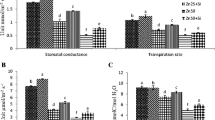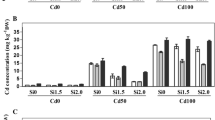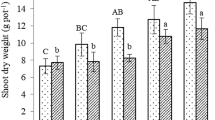Abstract
With the development of modern industry and agriculture, a large amount of 1,2,4-trichlorobenzene (TCB) is being discharged into the environment, which inhibits the growth of rice and threatens food production and food safety. Silicon plays an important role in the process of plants coping with stress, but little is known about the mechanism of silicon regulating TCB tolerance in rice. In this study, two rice varieties with different TCB resistance were studied to explore the alleviating effect and mechanism of silicon on TCB stress in rice. The results showed that silicon alleviated the inhibitory effect of TCB stress on rice growth, which was mainly manifested in that silicon increased the plant height, root length, dry weight and root activity of rice under TCB stress. Silicon alleviated the excessive accumulation of malondialdehyde caused by TCB, which was mainly due to the increase of antioxidant enzyme activity under TCB stress. Similarly, silicon also increases the soluble protein content in rice. In conclusion, silicon enhanced the tolerance of rice to TCB, the performance of rice varieties with different TCB resistance is consistent. This study has guiding significance and theoretical basis for rice production under TCB stress.
Similar content being viewed by others
Data Availability
All data generated or analysed during this study are included in this published article.
References
Katsoyiannis A, Samara C (2004) Persistent organic pollutants (POPS) in the sewage treatment plant of Thessaloniki, northern Greece: occurrence and removal. Water Res 11:2685–2698. https://doi.org/10.1016/j.watres.2004.03.027
Meharg AA, Wright J, Osborn D (2000) Chlorobenzenes in rivers draining industrial catchments. Sci Total Environ 243–253 https://doi.org/10.1016/s0048-9697(00)00387-9
Niu Y et al (2022) Exogenous silicon enhances resistance to 1,2,4-trichlorobenzene in rice. Sci Total Environ. https://doi.org/10.1016/j.scitotenv.2022.157248
Wang MJ, Jones KC (1994) UPTAKE OF CHLOROBENZENES BY CARROTS FROM SPIKED AND SEWAGE SLUDGE-AMENDED SOIL. Environ Sci Technol 7:1260–1267. https://doi.org/10.1021/es00056a013
de Araujo BS et al (2006) Uptake and transformation of phenol and chlorophenols by hairy root cultures of Daucus carota, Ipomoea batatas and Solanum aviculare. Chemosphere 4:642–651. https://doi.org/10.1016/j.chemosphere.2005.08.005
Katsoyiannis A, Samara C (2007) Comparison of active and passive sampling for the determination of persistent organic pollutants (POPs) in sewage treatment plants. Chemosphere 7:1375–1382. https://doi.org/10.1016/j.chemosphere.2006.10.035
Valkusz Z et al (2011) Further analysis of behavioral and endocrine consequences of chronic exposure of male Wistar rats to subtoxic doses of endocrine disruptor chlorobenzenes. Physiol Behav 5:421–430. https://doi.org/10.1016/j.physbeh.2011.03.016
Niu Y et al (2022) Comprehensive Evaluation and Screening for 1,2,4-Trichlorobenzene Tolerance in Rice Cultivars at Different Growth Stages. J Plant Growth Regul. https://doi.org/10.1007/s00344-021-10537-6
Díaz J, Rendueles M, Díaz M (2006) 1,2,4-Trichlorobenzene Flow Characteristics in Saturated Homogeneous and Stratified Porous Media. Water Air Soil Pollut 1–4:3–17. https://doi.org/10.1007/s11270-005-9019-4
He YW et al (1996) Fate of 1,2,4-trichlorobenzene (1,2,4-TCB) in soil-rice paddy system. Chemosphere 7:1381–1389. https://doi.org/10.1016/0045-6535(96)00047-1
Hou Y, Chu W, Ma M (2012) Carbonaceous and nitrogenous disinfection by-product formation in the surface and ground water treatment plants using Yellow River as water source. J Environ Sci 7:1204–1209. https://doi.org/10.1016/s1001-0742(11)61006-1
Wang MJ, Jones KC (1994) Occurrence of chlorobenzenes in 9 united-kingdom retail vegetables. J Agr Food Chem 10:2322–2328. https://doi.org/10.1021/jf00046a046
Zhang JY et al (2005) Tissue-dependent distribution and accumulation of chlorobenzenes by vegetables in urban area. Environ Int 6:855–860. https://doi.org/10.1016/j.envint.2005.05.034
ZG, W., et al (2006) Effects of 1,2,4-trichlorobenzene and naphthalene on growth of rice seedling. J Agr-Environ Sci 6:1402–1407
Barbour JP, Smith JA, Chiou CT (2005) Sorption of aromatic organic pollutants to grasses from water. Environ Sci Technol 21:8369–8373. https://doi.org/10.1021/es0504946
Wang MJ, Jones KC (1994) Behavior and fate of chlorobenzenes (cbs) introduced into soil-plant systems by sewage-sludge application - a review. Chemosphere 7:1325–1360. https://doi.org/10.1016/0045-6535(94)90077-9
Liu W et al (2003) 1,2,4-trichlorobenzene induction of chromosomal aberrations and cell division of root-tip cells in Vicia faba seedlings. Bull Environ Contam Toxicol 4:689–697. https://doi.org/10.1007/s00128-003-0188-9
Liu W et al (2004) Root growth inhibition and induction of DNA damage in soybean (Glycine max) by chlorobenzenes in contaminated soil. Chemosphere 2:101–106. https://doi.org/10.1016/j.chemosphere.2004.04.045
Miguel AS et al (2012) Biological responses of maize (Zea mays) plants exposed to chlorobenzenes. Case study of monochloro-, 1,4-dichloro- and 1,2,4-trichloro-benzenes. Ecotoxicology 2:315–324. https://doi.org/10.1007/s10646-011-0792-0
Nouri MZ, Moumeni A, Komatsu S (2015) Abiotic Stresses: Insight into Gene Regulation and Protein Expression in Photosynthetic Pathways of Plants. Int J Mol Sci 9:20392–20416. https://doi.org/10.3390/ijms160920392
Du Q, Jia X, Yuan B (2006) Toxic effects of 1,2,4-trichlorobenzene on rice seed germination and seedling growth. Yingyong Shengtai Xuebao 11:2185–2188
Liu W et al (2002) Effects of 1, 2, 4-trichlorobenzene stress on active oxygen in germinated soybean seeds. Yingyong Shengtai Xuebao 12:1655–1658
Ge C et al (2009) Responses of wheat seedlings to cadmium, mercury and trichlorobenzene stresses. J Environ Sci 6:806–813. https://doi.org/10.1016/s1001-0742(08)62345-1
San Miguel A et al (2013) Response of phase II detoxification enzymes in Phragmites australis plants exposed to organochlorines. Environ Sci Pollut Res 5:3464–3471. https://doi.org/10.1007/s11356-012-1301-6
Ahire ML et al (2021) Multifaceted roles of silicon in mitigating environmental stresses in plants. Plant Physio Bioch 291–310 https://doi.org/10.1016/j.plaphy.2021.11.010
Gupta BK et al (2021) Silicon nutrition stimulates Salt-Overly Sensitive (SOS) pathway to enhance salinity stress tolerance and yield in rice. Plant Physio Bioch 593–604 https://doi.org/10.1016/j.plaphy.2021.06.010
Coskun D et al (2016) The Role of Silicon in Higher Plants under Salinity and Drought Stress. Front Plant Sci 1072 https://doi.org/10.3389/fpls.2016.01072
Zhou Q et al (2022) Silicon-enhanced tolerance to cadmium toxicity in soybean by enhancing antioxidant defense capacity and changing cadmium distribution and transport. Ecotoxicol Environ Saf 113766–113766 https://doi.org/10.1016/j.ecoenv.2022.113766.
Ranjan A et al (2021) Silicon-mediated abiotic and biotic stress mitigation in plants: Underlying mechanisms and potential for stress resilient agriculture. Plant Physio Bioch 15–25 https://doi.org/10.1016/j.plaphy.2021.03.044
Hasanuzzaman M et al (2019) Silicon-induced antioxidant defense and methylglyoxal detoxification works coordinately in alleviating nickel toxicity in Oryza sativa L. Ecotoxicology 3:261–276. https://doi.org/10.1007/s10646-019-02019-z
Biju S, Fuentes S, Gupta D (2021) Silicon modulates nitro-oxidative homeostasis along with the antioxidant metabolism to promote drought stress tolerance in lentil plants. Physiol Plantarum 2:1382–1398. https://doi.org/10.1111/ppl.13437
Altaf MM et al (2022) Silicon-mediated metabolic upregulation of ascorbate glutathione (AsA-GSH) and glyoxalase reduces the toxic effects of vanadium in rice. J Hazard Mater 129145–129145 https://doi.org/10.1016/j.jhazmat.2022.129145
Pan T et al (2022) Silicon enhances the submergence tolerance of rice by regulating quiescence strategy and alleviating oxidative damage. Plant Physio Bioch 124–132 https://doi.org/10.1016/j.plaphy.2022.04.018
Liu JG et al (2008) Allelopathic effects of cotton in continuous cropping. Allelopathy J 2:299–305
Bradford MM (1976) A rapid and sensitive method for the quantitation of microgram quantities of protein utilizing the principle of protein-dye binding. Anal Biochem 248–54 https://doi.org/10.1006/abio.1976.9999
Wang YS et al (2013) Analysis of Interfering Substances in the Measurement of Malondialdehyde Content in Plant Leaves. Asian Chem 11:6293–6297. https://doi.org/10.14233/ajchem.2013.14411
Beauchamp C, Fridovich I (1971) Superoxide dismutase: improved assays and an assay applicable to acrylamide gels. Anal Biochem 1:276–287. https://doi.org/10.1016/0003-2697(71)90370-8
Nickel KS, Cunningham BA (1969) Improved peroxidase assay method using leuco 2,3’,6-trichloroindophenol and application to comparative measurements of peroxidatic catalysis. Anal Biochem 2:292–299
Lukacova Z et al (2019) Tobacco plants (Nicotiana benthamiana) were influenced by silicon and were not infected by dodder (Cuscuta europaea). Plant Physio Bioch 179–190 https://doi.org/10.1016/j.plaphy.2019.03.004
Ge C et al (2008) A proteomic analysis of rice seedlings responding to 1,2,4-trichlorobenzene stress. J Environ Sci 3:309–319. https://doi.org/10.1016/s1001-0742(08)60049-2
Zhang B et al (2012) Physiological and biochemical response of wheat seedlings to organic pollutant 1, 2, 4-trichlorobenzene. New Zeal J Crop and Hort 2:73–85. https://doi.org/10.1080/01140671.2011.610324
Halder T, et al (2022) Wheat Proteomics for Abiotic Stress Tolerance and Root System Architecture: Current Status and Future Prospects. Proteomes 2: https://doi.org/10.3390/proteomes10020017
Rastogi A et al (2021) Does silicon really matter for the photosynthetic machinery in plants? Plant Physio Bioch 40–48 https://doi.org/10.1016/j.plaphy.2021.11.004
Chaiwong N, Prom-u-thai C (2022) Significant Roles of Silicon for Improving Crop Productivity and Factors Affecting Silicon Uptake and Accumulation in Rice: a Review. J Soil Sci Plant Nut 2:1970–1982. https://doi.org/10.1007/s42729-022-00787-y
Liang XL et al (2015) The Positive Effects of Silicon on Rice Seedlings Under Saline-Alkali Mixed Stress. Commun Soil Sci Plan 17:2127–2138. https://doi.org/10.1080/00103624.2015.1059848
Liang YC et al (2007) Mechanisms of silicon-mediated alleviation of abiotic stresses in higher plants: A review. Environ Pollut 2:422–428. https://doi.org/10.1016/j.envpol.2006.06.008
You J, Chan ZL (2015) ROS Regulation During Abiotic Stress Responses in Crop Plants. Front Plant Sci. https://doi.org/10.3389/fpls.2015.01092
Mittler R et al (2022) Reactive oxygen species signalling in plant stress responses. Nat Rev Mol Cell Bio 663–679 https://doi.org/10.1038/s41580-022-00499-2
Liu C, Liao WB (2022) Potassium signaling in plant abiotic responses: Crosstalk with calcium and reactive oxygen species/reactive nitrogen species. Plant Physio Bioch 110–121 https://doi.org/10.1016/j.plaphy.2022.01.016
Moller IM, Jensen PE, Hansson A (2007) Oxidative modifications to cellular components in plants. Annu Rev Plant Biol 459–481 https://doi.org/10.1146/annurev.arplant.58.032806.103946
Chen D et al (2019) Effects of boron, silicon and their interactions on cadmium accumulation and toxicity in rice plants. J Hazard Mater 447–455 https://doi.org/10.1016/j.jhazmat.2018.12.111
Mostofa MG et al (2021) Silicon in mitigation of abiotic stress-induced oxidative damage in plants. Crit Rev Biotechno 6:918–934. https://doi.org/10.1080/07388551.2021.1892582
Khan I et al (2022) Silicon: an essential element for plant nutrition and phytohormones signaling mechanism under stressful conditions. Plant Growth Regula. https://doi.org/10.1007/s10725-022-00872-3
Chen JN et al (2016) Influence of exogenous silicon on UV-B radiation-induced cyclobutane pyrimidine dimmers in soybean leaves and its alleviation mechanism. J Plant Physiol 20–27 https://doi.org/10.1016/j.jplph.2016.01.019
Patel M, Fatnani D, Parida AK (2021) Silicon-induced mitigation of drought stress in peanut genotypes (Arachis hypogaea L.) through ion homeostasis, modulations of antioxidative defense system, and metabolic regulations. Plant Physio Bioch 290–313 https://doi.org/10.1016/j.plaphy.2021.06.003.
Singh D et al (2022) Hydrogen Sulfide and Silicon Together Alleviate Chromium (VI) Toxicity by Modulating Morpho-Physiological and Key Antioxidant Defense Systems in Chickpea (Cicer arietinum L.) Varieties. Front Plant Sci https://doi.org/10.3389/fpls.2022.963394.
Gunes A et al (2007) Influence of silicon on antioxidant mechanisms and lipid peroxidation in chickpea (Cicer arietinum L.) cultivars under drought stress. J Plant Interact 2:105–113. https://doi.org/10.1080/17429140701529399
Yang ZH et al (2022) Effects of Silicon and Iron Application on Arsenic Absorption and Physiological Characteristics of Rice (Oryza sativa L.). Bull Environ Contam Toxicol 6:1046–1055. https://doi.org/10.1007/s00128-022-03476-9
Li LL et al (2022) Ameliorative Effects of Silicon against Salt Stress in Gossypium hirsutum L. Antioxidants 8: https://doi.org/10.3390/antiox11081520.
Dhakate P et al (2022) Silicon nanoforms in crop improvement and stress management. Chemosphere. https://doi.org/10.1016/j.chemosphere.2022.135165
Dinakar C, Djilianov D, Bartels D (2012) Photosynthesis in desiccation tolerant plants: Energy metabolism and antioxidative stress defense. Plant Sci 29–41 https://doi.org/10.1016/j.plantsci.2011.01.018.
Munns R, Tester M (2008) Mechanisms of salinity tolerance. Annu Rev Plant Biol 651–681 https://doi.org/10.1146/annurev.arplant.59.032607.092911
Munns R et al (2020) Energy costs of salt tolerance in crop plants. New Phytol 3:1072–1090. https://doi.org/10.1111/nph.15864
Qureshi MI, Qadir S, Zolla L (2007) Proteo mics-based dissection of stress-responsive pathways in plants. J Plant Physiol 10:1239–1260. https://doi.org/10.1016/j.jplph.2007.01.013
Kim YH et al (2017) Silicon Regulates Antioxidant Activities of Crop Plants under Abiotic-Induced Oxidative Stress: A Review. Front Plant Sci. https://doi.org/10.3389/fpls.2017.00510
Alche JD (2019) A concise appraisal of lipid oxidation and lipoxidation in higher plants. Redox Biol. https://doi.org/10.1016/j.redox.2019.101136
Funding
This study was supported by the National Natural Science Foundation of China (Grant No. 31771736, 31271639), State Key Laboratory of Soil and Sustainable Agriculture (Grant No. Y052010016), National Programs for Coordinated Promotion of Major Agricultural Technologies (Grant No.2021-ZYXT-02–1), Key Projects of Key research and Development Programs of Jiangsu Province (Grant No. BE2021323), the Jiangsu Overseas Visiting Scholar Program for University Prominent Young and Middle-aged Teachers (Grant No. 2017), Talent Introduction Research Project of Huaiyin Institute of Technology (Z301B22504).
Author information
Authors and Affiliations
Contributions
Conceptualization, Guoliang Zhang; methodology, Feiyu Yan; software, Feiyu Yan; validation, Feiyu Yan, Linqing Zhang, Le Liu, Xinhai Liu, Fang Wang, Zhiwei Huang, Hongliang Zhao, and Guoliang Zhang; formal analysis, Feiyu Yan; investigation, Feiyu Yan, Linqing Zhang, Le Liu; resources, Feiyu Yan; data curation, Linqing Zhang; writing-original draft preparation, Feiyu Yan.; writing-review and editing, Feiyu Yan, Linqing Zhang, Le Liu; visualization, Feiyu Yan; supervision, Guoliang Zhang; funding acquisition: Guoliang Zhang. All authors have read and agreed to the published version of the manuscript.
Corresponding author
Ethics declarations
Ethics Approval
Not applicable.
Consent to Participate
All authors were highly cooperative and involved in research activities and preparation of this article.
Consent for Publication
All authors agreed to publish this research article.
Conflict of Interest
The authors declare no competing interests.
Additional information
Publisher's Note
Springer Nature remains neutral with regard to jurisdictional claims in published maps and institutional affiliations.
Feiyu Yan, Linqing Zhang and Le Liu equal first author.
Supplementary Information
Below is the link to the electronic supplementary material.
Rights and permissions
Springer Nature or its licensor (e.g. a society or other partner) holds exclusive rights to this article under a publishing agreement with the author(s) or other rightsholder(s); author self-archiving of the accepted manuscript version of this article is solely governed by the terms of such publishing agreement and applicable law.
About this article
Cite this article
Yan, F., Zhang, L., Liu, L. et al. Silicon Alleviates the Stress of 1,2,4-Trichlorobenzene on Rice Seedlings. Silicon 15, 7371–7381 (2023). https://doi.org/10.1007/s12633-023-02591-4
Received:
Accepted:
Published:
Issue Date:
DOI: https://doi.org/10.1007/s12633-023-02591-4




